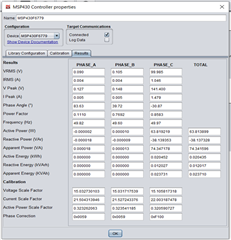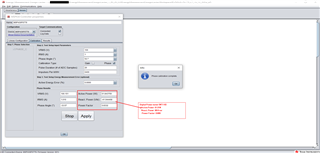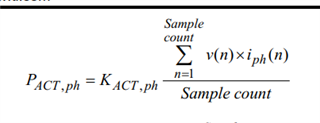Hi experts,
My customer is performing an evaluation using the EVM430-F6779 (TI EVM) and Energy Measurement Design Center (EMDC).
Sample Project:EVM430-F6779_RC_3V_3C_60Hz
As a result of measuring with three types of equipment: a power meter, a watt meter from another manufacturer, and TI EVM, only the TI EVM gave different results.
Q1:Are the calculation methods used in the GUI correct? The values of power factor, reactive power, and apparent power seem to be different from the theoretical values.
Q2: Is there a way to correct the calculation method if it is incorrect?
Q3: Is it correct that the GUI results are calculated within the CPU? (The GUI only communicates via UART and displays the results)
The result is as follows.
Power meters and watt meters from other manufacturers display measured values, while TI EVM displays results on the GUI.
| Digital Power meter | Watt meter from another manufacturer | TI EVM | |||||||||||||||||||||||
| AC(V) | load current(mA) | Voltage(V) | Current(A) | Power(W) | Frequency(Hz) | Power Factor(PF) | Reactive power(var) | Apparent power(VA) | Voltage(V) | Current(A) | Power(W) | Frequency(Hz) | Power Factor(PF) | Reactive power(var) | Apparent power(VA) | Voltage(V) | Current(A) | Power(W) | Frequency(Hz) | Power Factor(PF) | Reactive power(var) | Apparent power(VA) | |||
| AC 100 |
100 | 100.1 | 0.081 | 2.98 | 50 | 0.375 | 7.73 | 8.33 | 100.1 | 0.062 | 2 | 50 | 0.35 | 6 | - | 99.9 | 0.057 | 2.19 | 49.97 | 0.93 | 0.86 | 2.37 | |||
| 200 | 100.1 | 0.128 | 5.21 | 50 | 0.403 | 11.9 | 12.95 | 100.1 | 0.108 | 4 | 50 | 0.39 | 10 | - | 99.9 | 0.102 | 4.3 | 49.97 | 0.96 | 1.24 | 4.5 | ||||
| 300 | 100.1 | 0.167 | 7.3 | 50 | 0.434 | 15 | 16.82 | 100.1 | 0.149 | 6 | 50 | 0.42 | 14 | - | 99.9 | 0.142 | 6.36 | 49.97 | 0.97 | 1.728 | 6.61 | ||||
| 400 | 100.1 | 0.203 | 9.33 | 50 | 0.459 | 18.1 | 20.4 | 100.1 | 0.187 | 8 | 50 | 0.45 | 17 | - | 99.9 | 0.18 | 8.4 | 49.97 | 0.96 | 2.3 | 8.73 | ||||
| 500 | 100.1 | 0.238 | 11.43 | 50 | 0.478 | 21.03 | 23.96 | 100.1 | 0.224 | 11 | 50 | 0.47 | 20 | - | 99.9 | 0.216 | 10.5 | 49.97 | 0.96 | 2.99 | 10.93 | ||||
| 600 | 100.1 | 0.272 | 13..5 | 50 | 0.494 | 23.76 | 27.39 | 100.1 | 0.259 | 13 | 50 | 0.48 | 23 | - | 99.8 | 0.251 | 12.58 | 49.97 | 0.96 | 3.74 | 13.13 | ||||
| 700 | 100.1 | 0.304 | 15.5 | 50 | 0.508 | 26.38 | 30.65 | 100 | 0.292 | 15 | 50 | 0.5 | 25 | - | 99.8 | 0.284 | 14.61 | 49.97 | 0.95 | 4.54 | 15.29 | ||||
| 800 | 100.1 | 0.337 | 17.6 | 50 | 0.52 | 28.95 | 33.94 | 100 | 0.326 | 17 | 50 | 0.51 | 28 | - | 99.8 | 0.317 | 16.67 | 49.97 | 0.95 | 5.4 | 17.54 | ||||
| 900 | 100.1 | 0.369 | 19.7 | 50 | 0.53 | 31.45 | 37.17 | 100 | 0.358 | 19 | 50 | 0.52 | 31 | - | 99.8 | 0.35 | 18.75 | 49.97 | 0.94 | 6.4 | 19.82 | ||||
| 1000 | 100.1 | 0.401 | 21.8 | 50 | 0.541 | 33.9 | 40.4 | 100 | 0.391 | 21 | 50 | 0.53 | 33 | - | 99.8 | 0.382 | 20.86 | 49.97 | 0.94 | 7.42 | 22.13 | ||||
| 1250 | 100.1 | 0.481 | 27.1 | 50 | 0.561 | 39.98 | 48.3 | 100 | 0.471 | 26 | 50 | 0.55 | 39 | - | 99.8 | 0.462 | 26.15 | 49.97 | 0.93 | 10.2 | 28 | ||||
| 1500 | 100.1 | 0.558 | 32.3 | 50 | 0.577 | 45.7 | 56.1 | 100 | 0.549 | 31 | 50 | 0.57 | 45 | - | 99.8 | 0.539 | 31.28 | 49.97 | 0.92 | 13.3 | 34 | ||||
| 1750 | 100.1 | 0.636 | 37.6 | 50 | 0.59 | 51.5 | 63.8 | 99.9 | 0.627 | 37 | 50 | 0.58 | 51 | - | 99.7 | 0.617 | 36.61 | 49.97 | 0.91 | 16.85 | 40.3 | ||||
| 2000 | 100.1 | 0.714 | 42.9 | 50 | 0.6 | 57.3 | 71.6 | 99.9 | 0.705 | 42 | 50 | 0.59 | 57 | - | 99.7 | 0.694 | 41.87 | 49.97 | 0.89 | 20.7 | 46.7 | ||||
| 2250 | 100.1 | 0.794 | 48.3 | 50 | 0.606 | 63.1 | 79.5 | 99.9 | 0.785 | 47 | 50 | 0.6 | 63 | - | 99.6 | 0.774 | 47.23 | 49.97 | 0.88 | 24.95 | 53.4 | ||||
| 2500 | 100.1 | 0.874 | 53.6 | 50 | 0.613 | 69.2 | 87.6 | 99.9 | 0.865 | 53 | 50 | 0.61 | 68 | - | 99.6 | 0.854 | 52.59 | 49.97 | 0.87 | 29.5 | 60.3 | ||||
| 2750 | 100 | 0.957 | 59.2 | 50 | 0.617 | 75.4 | 95.9 | 99.9 | 0.948 | 58 | 50 | 0.61 | 75 | - | 99.6 | 0.937 | 58.07 | 49.97 | 0.86 | 34.62 | 67.6 | ||||
| 3000 | 100 | 1.043 | 64.8 | 50 | 0.621 | 81.9 | 104.5 | 99.9 | 1.034 | 64 | 50 | 0.62 | 81 | - | 99.6 | 1.022 | 63.65 | 49.97 | 0.84 | 40.18 | 75.2 | ||||
Best regards,
O.H









